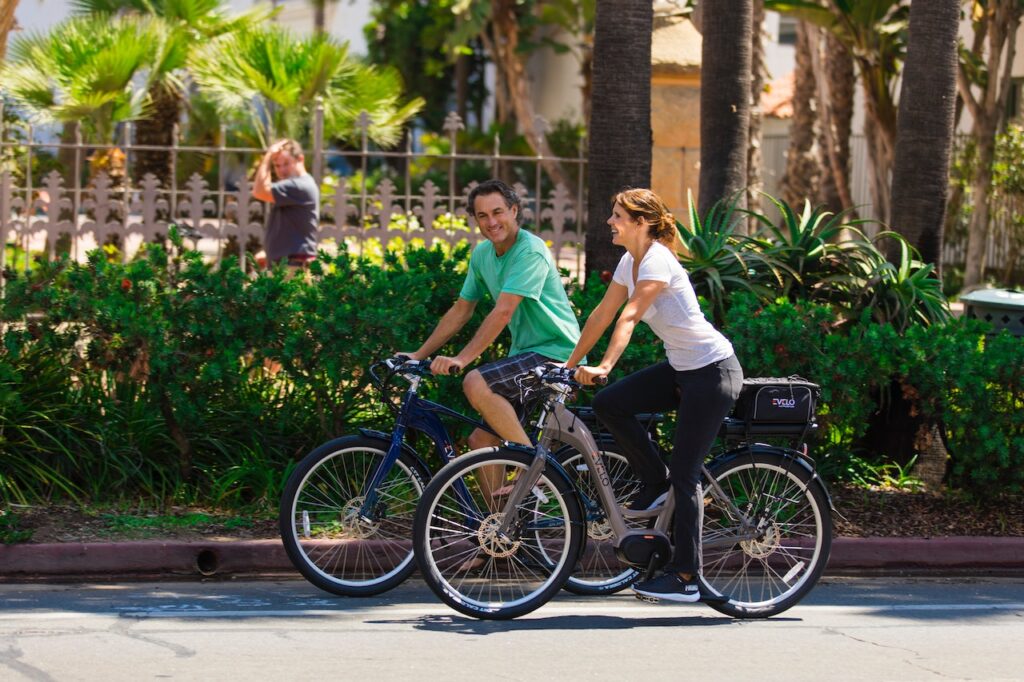One of the most important aspects of owning an electric bike is how far it can take you on a single charge. You don’t want to have to guess or experience the stress of range anxiety. So, how do you calculate Ebike range?
In this article, I’ll give you the calculation and discuss why determining range isn’t so clear cut.
Electric Bike Range Calculation
First, let’s look at the numbers you need to know to work out your electric bike’s range:
- Volts (V)
- Amp Hours (Ah)
- Watt-Hours (wh)
You can find the battery volts and Amp hours in your electric bike’s technical specifications. When you know these two figures, you can work out the watt-hours by multiplying them. The Watt-hour figure is the battery’s power density.
For example, consider an electric bike with a 48V battery and 14 Ah:
48 x 14 = 672 watt-hours (Wh)
Typically, you use up about 20 watt-hours (Wh) per mile. Therefore, you need to divide your watt-hour figure by 20:
672/20=33.6 miles. That’s how you calculate your range.
However, this calculated range doesn’t consider real-world riding and all the variables involved. Therefore, in reality, your range could be higher or lower. So, you need to take your calculation into account, and then look at what type of ride you’re going into.

What Affects Your Electric Bike’s Range?
Several factors make a difference in how far you can ride your ebike before recharging. Let’s take a close look at each one:
Motor Power
Motor power dramatically makes a difference to an e-bike’s performance. Higher wattage motors give you faster acceleration and more torque. Lots of torque helps you climb more easily, especially if you’re carrying lots of weight. The downside of powerful motors is that they drain your battery faster, reducing your range. Powerful electric bikes require larger batteries, which contributes to the already heavy motor.
How much power your electric bike motor has is determined by personal choice and local laws. Most people will be fine with an electric bike with a 250W motor. Even some of the most rugged electric mountain bikes have this much power. However, if you want fast acceleration, speedy ascents on steep hills, or are quite heavy, you’d be better off with a more powerful electric bike.
How You Ride Your Electric Bike
Your behavior when riding significantly affects the battery’s range. For example, riding in a high assistance level for extended periods demands more energy from the battery, depleting it faster. This is the same story if you ride aggressively by accelerating hard constantly.
Riding more smoothly and thinking ahead will mean you don’t have to stop at traffic lights and junctions so often. This way, your demands on the battery are much less, allowing you to ride further.

The Profile Of Your Journey
If you ride in a flat area, your electric bike’s motor won’t have to work as hard as in a hilly area. Constant climbing sucks energy from your battery, reducing its range.
You cannot do anything about the local terrain, but you must be aware of it. You may need to adjust your riding habits, plan a suitable place to recharge, or carry an additional fully-charged battery to extend your range.
Weight
Weight is another thing that affects how far your battery can take you. Heavier riders and those with backpacks or a fully loaded cargo rack will notice they can’t ride as far as their lighter companions. Therefore, you need to be mindful of what you carry with you. Ask yourself the question, what can I leave at home?
Determining range gets a little more complicated when you carry a spare battery. This is because you carry the battery to extend your range, but its weight will drain the battery you’re using more quickly. In this case, carrying a spare battery with a smaller capacity is often best. Smaller batteries are lighter and should give you enough range to reach a power outlet.
Battery Capacity
To increase the range of your electric bike, you may be able to buy a higher-capacity battery. A battery with more watt-hours will take you further on a single charge.
However, be careful where you buy your battery, and make sure it is compatible with your electric bike. Cheap batteries from third-party suppliers often have inferior build quality and are dangerous. Most electric bike fires are caused by these cheap “upgrades,” so don’t take the risk.
Weather Conditions
Most electric bikes are designed to perform at their best during summer. However, being weary on extremely hot days is essential, as electric bike batteries are sensitive to high temperatures. Therefore, you may notice a reduction in range.
It is worth noting that Lithium-ion batteries for electric bikes perform best between 15.5 and 26.6 ° C. Also, battery performance degrades significantly below 4.4° C and above 46° C.
We all know what it’s like to ride into a headwind on a regular bike. This is not so much of a problem on an electric bike, but the motor has to work harder. This is similar to riding uphill, draining the battery faster.
The rain doesn’t make for as much of a problem – however if you’re on a slippery surface the motor will have to work harder to gain traction, so make sure your tires are up to scratch and suitable to acceleration on wet surfaces.
The Condition Of Your Electric Bike
Electric bikes require a little more care and attention than regular bikes, but this shouldn’t put you off buying one. Simple things like pumping the tires to the correct pressures make a difference to range. If your tires are too soft, their rolling resistance increases, demanding more energy from the battery.
You should also ensure your drivetrain is clean and in good condition. Extra friction from dirt and lack of lubrication not only damages it but reduces range, although only slightly.
Final Thoughts: Calculation and Consideration
So now you know how to calculate Ebike range. But you can also see that there are many real-world factors affecting how far you can ride before you need to recharge.
This is why you should take electric bike manufacturer’s range figures with a pinch of salt. They are a reasonable indication of how far a bike can go. Still, it would be best to remember they have based their figures on riding the bike in optimal conditions on a flat road.
You can read more electric bike tips on our blog, or, if you’re looking for a new ride check out our electric bike reviews.

